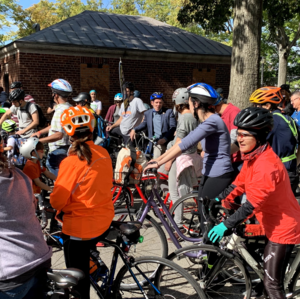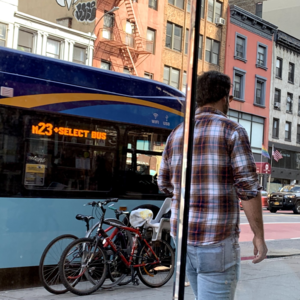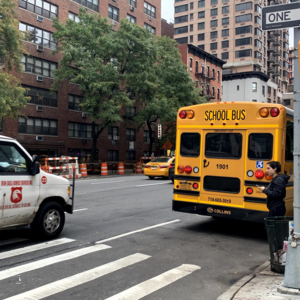“Bike lane? I’ll just be a minute.”
Oh really? Well, multiply you by the thousands of thoughtless SUV drivers and entitled truck drivers and absurd obstructions that people on bikes deal with every day, and it’s a wonder more people on bikes aren’t killed in this city.
Bike lanes are safety infrastructure! They exist because people on bikes are moving through the streets unprotected from people like you, who are moving around the city inside two- or three- or six-ton safety cages, usually too fast and almost always without proper care.
If you’re parked in a bike lane, or loading in a bike lane, or “just dropping someone off” in a bike lane, you’re pushing someone more vulnerable than you—someone who could easily be crushed to death, and much more easily break a leg or an arm—into active traffic. So don’t do it unless you genuinely have to!
What the law says: Don’t drive or park in bike lanes. And don’t even load passengers in them if you can avoid it.




Bicycles are good! They take cars off the street, pollutants out of the air, people out of crowded subway cars. They’re also legal to ride almost anywhere, and they’re more suited to the scale of New York City streets than cars or trucks. They’re not in your way; you’re in theirs.
Here’s the law (with some common sense mixed in):
Bicycles are welcome on every street in New York City except for expressways and parkways. Where bike lanes are provided, riders should use them where it’s safe; wherever it isn’t safe, or on the vast majority of NYC streets where bike lanes don’t exist, riders belong in regular traffic lanes.
Don’t hassle people on bikes. We are legal users of the streets! So don’t honk at us, don’t pass us too closely, don’t impatiently go around us just to stop at a light four seconds later. Why would you do something that might get one of us killed?
Don’t ever drive in bike lanes. If you are one of the rare exceptions (e.g., firefighter actively putting out a fire), you already know. If not, stop doing it!
Don’t ever park in bike lanes. Bike lanes are traffic lanes. Would you park on the Manhattan Bridge? If not, don’t block bicycle safety infrastructure. It exists to keep people from getting killed in traffic.
Don’t stop in bike lanes to load passengers or cargo. There’s a common conception that it’s fine to stop in bike lanes for “just a minute.” This gets people injured. Don’t do it unless you have genuine need, e.g., you’re actively loading a mobility-impaired passenger.
It seems dumb to have to say this, but: Don’t walk or stand in bike lanes. Bike 👏 lanes 👏 are 👏 traffic 👏 lanes 👏 and that traffic is often going 20 miles an hour. Why would you walk where a 200-pound object going 20 miles an hour could easily hit you?
If your construction or road works project impacts a bike lane, even for a short time, you have to provide a safe detour. Some companies like Con Ed and Verizon tend to be very scrupulous about this (thank you!); others, not so much. Remember that (we’ll say it again) bike lanes are safety infrastructure; their purpose is to keep human beings from getting hit and killed. Treat them with the respect they deserve.
What actually happens: Bike lanes are fair game for all kinds of dangerous obstructions.




Things are better than they used to be. And we get it! The city is crowded! But (once more for the people in the back) bike lanes are safety infrastructure. They’re not parking or loading zones. And the enforcement that keeps them clear is … well, let’s just say it’s imperfect.
In some parts of the city, the NYPD occasionally makes the right kinds of noises about trying to keep bike lanes clear of obstructions, but they rarely back themselves up with action. In others, the police are actively making things more dangerous by parking in them.
In most NYC bike lanes, even with basic enforcement, it’s difficult to go three blocks crosstown or five blocks downtown without encountering an obstruction anyway: parked SUV, truck unloading vegetables, dumpster, file cabinet, pile of garbage, who the hell knows. Every day’s a fresh adventure in the big city.


